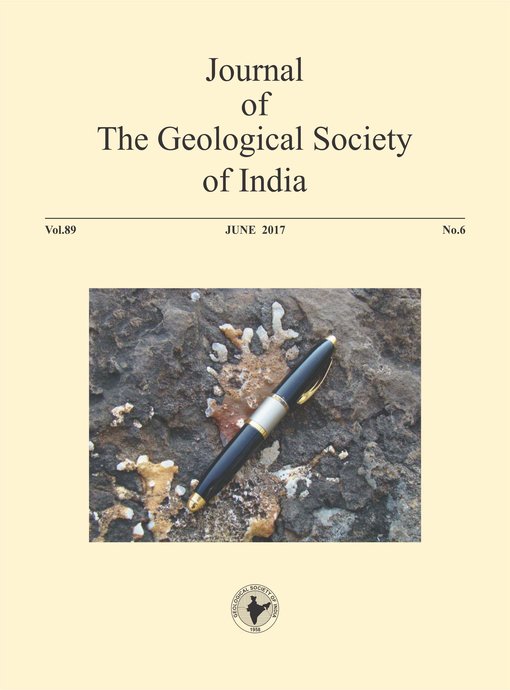East-West Mafic Dyke in Aravallis – A Post-Depositional Event Deciphered by Aeromagnetic Studies
DOI:
https://doi.org/10.1007/s12594-017-0677-9Abstract
Aravalli fold belt has witnessed major tectonism resulting in intense deformation and associated mafic magmatism. Recently acquired high resolution aeromagnetic data over central Aravalli fold belt brought out a conspicuous E-W trending magnetic anomaly extending for more than 35 km in length cutting across the whole succession of Aravalli Supergroup. This anomaly on ground is manifested as undeformed basic dyke intruding into metasediments of Aravalli Supergroup. The E-W trend and undeformed nature of these dykes suggest that they represent post Aravalli mafic magmatism which are emplaced sympathetic to the axial plane of F3 folding.Downloads
Metrics
Issue
Section
Downloads
Published
How to Cite
References
Devaraju, T.C., Viljoen, R. P., Sawkar, R.H. and Sudhakara, T.L. (2009) Mafic and Ultramafic Magmatism and Associated Mineralization in the Dharwar craton, Southern India. Jour. Geol. Soc. India, v.73, pp.73-100.
Durry, S.A. (1990) SPOT image data as an aid to structural mapping in the southern Aravalli hills of Rajasthan, India. Geol. Mag., v.127, pp.195-207
French, J.E., Heaman, L.M., Chacko, T. and Srivastava, R.K. (2008) 1891– 1883 Ma SouthernBastar-Cuddapah mafic igneous events, India: a newly recognized Large IgneousProvince. Precambrian Res., v.160, pp.308–322.
Gopalan, K., MacDougall, J.D., Roy, A.B. and Murali, A.V. (1990) Sm-Nd evidence for 3.3 Ga old rocks in Rajasthan, Northwestern India. Precambrian Res., v.48, pp.287-297.
Gupta, S.N., Arora, Y.K., Mathur, R.K., Iqbaluddin, Prasad, B., Sahai, T.N. and Sharma, S.B. (1980) Lithostratigraphic map of Aravalli region (1:1000000). Geol. Surv. India, Calcutta.
Gupta, S.N., Arora, Y.K., Mathur, R.K., Iqbaluddin, Prasad, B., Sahai, T.N. and Sharma, S.B. (1997) The Precambrian geology of the Aravalli region, southern Rajasthan and northern Gujarat. Geol. Surv. India, v.123, p.262.
Heron, A.M. (1953) The geology of central Rajputana. Mem. Geol. Surv. India, v.79, 389p.
Hunt, J., Baker, T. and Thorkelson, D. (2005) Regional-scale Proterozoic IOCGmineralized breccia systems: examples from the Wernecke Mountains, Yukon, Canada. Mineralium Deposita, v.40(5), pp.492-514.
Li, Y. and Oldenburg, D.W. (1996) 3-D inversion of magnetic data. Geophysics, v.61(2), pp.394-408.
Li, Y. and Oldenburg, D.W. (2003) Fast inversion of large-scale magnetic data using wavelet transforms and a logarithmic barrier method. Geophys. Jour. Internat., v.152(2), pp.251-265.
Murthy, N.G.K. (1987) Mafic dyke swarms of the Indian Shield. In: Halls, H.C., Fahrig,W.F. (Eds.), Mafic Dyke Swarms. Geol. Assoc. Canada, Special Paper, v.34, pp.393-400.
Naha, K., Mukhopadhyay, D.K., Mohanty, R., Mitra, S.K. and Biswal, T.K. (1984) Significance of contrast in early stages of the structural history of the Delhi and pre-Delhi groups in the proterozoic of Rajasthan, Western India, Tectonophysics, v.105, pp.193-206
Paliwal, B.S. (1988) Deformation pattern in the rocks of the Aravalli Supergroup around Udaipur city, Rajasthan. Mem. Geol. Soc. India, no.7, pp.153-168.
Roy, A.B. (2000) Geology of the paleoproterozoic of the Aravalli Supergroup of Rajasthan and Northern Gujarat. In: M. Deb (Ed.), Crustal evolution and metalogene in the northwestern Indian shield. Narosa Publishing House, pp.87-114.
Roy, A.B. and Jakhar, S.R. (2002) Geology of Rajasthan (Northwest India): Precambrian to Recent. Scientific Publishers (India), Jodhpur.
Sahu, B.K. (2012) Aeromagnetic data analysis of the southern Aravalli Fold belt: Its implecation in understanding the interrelationship among the migmatities and gneissic rocks, Aravalli Supergroup and Godhra Granite. Jour. Geol. Soc. India, v.80, pp..255-261
Sinha-Roy, S. (1988) Proterozoic Wilson Cycles in Rajasthan. Mem. Geol. Soc. India, no. 7, pp.95-107.
Sinha-Roy, S., Malhotra, G., and Mohanty, M. (1998) Geology of Rajasthan. Geol. Soc. India, Bangalore, 273p.
Srivastava, R.K. (2011) Dyke Swarms: Keys for Geodynamic Interpretation. Springer-Verlag, Heidelberg, 605p.

 A. K. Pathak
A. K. Pathak






